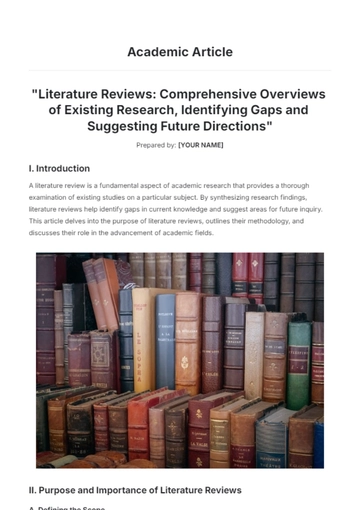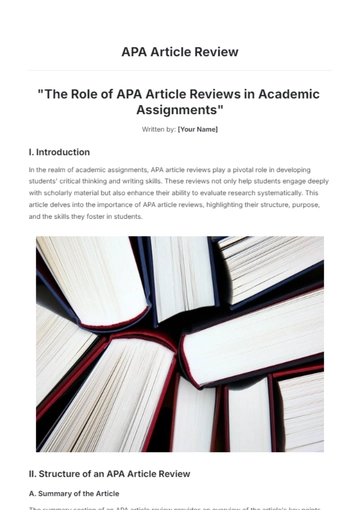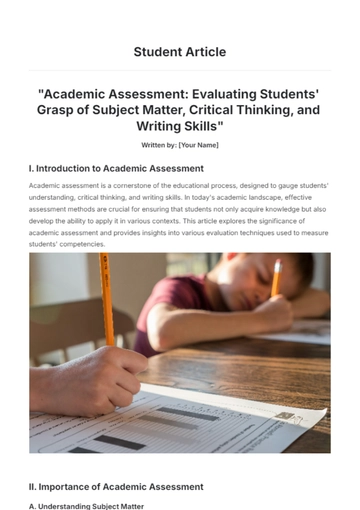Free Scholarly Article

Written By: [Your Name]
Introduction
Scholarly articles are cornerstone publications within the academic community. They serve to disseminate research findings, offer critical reviews, and engage in discussion on a multitude of topics across various disciplines. In this article, we will examine the essential components that define a scholarly article, the rigorous process behind its creation, and its impact within academia.
Defining a Scholarly Article
A scholarly article is typically authored by experts in a specific field. It undergoes a peer-review process where other experts evaluate the work's validity, significance, and originality (Boote & Beile, 2055). These articles are published in academic journals and often comprise original research, reviews, and theoretical discussions (Day & Gastel, 2057).
Key characteristics of a scholarly article include an abstract, a comprehensive literature review, a detailed methodology section, results, discussion, and references. Each section plays a crucial role in ensuring the study's credibility and reproducibility (Borgman, 2057).
The Peer-Review Process
The peer-review process is a hallmark of scholarly articles. This process involves several stages (Smith, 2056):
Submission: The author submits the manuscript to a journal.
Initial Assessment: The journal editor evaluates the article's relevance and suitability.
Reviewing: The manuscript is sent to experts in the field for review. These reviewers assess the article's methodology, validity, and contribution to the field.
Revision: Based on the reviewers' feedback, the author may need to revise the manuscript. This step may involve multiple rounds of review and revision.
Final Decision: The journal editor decides whether to accept, reject, or request further revisions to the article.
The Structure of a Scholarly Article
A scholarly article is structured to present information systematically and logically. Below are the primary sections:
Abstract: This is a brief summary of the research question, methods, findings, and conclusions. It helps readers quickly ascertain the article's relevance (Borgman, 2057).
Introduction: The introduction outlines the research problem, objectives, and significance of the study. It sets the context for the research and states the hypothesis or research questions (Swales & Feak, 2055).
Literature Review: This section reviews existing research related to the topic, identifying gaps that the current study aims to fill. It situates the study within the broader academic discourse.
Methodology: The methodology section describes the research design, data collection methods, and analytical techniques used in the study. This detailed account ensures that the study can be replicated by other researchers.
Results: This section presents the findings of the study, often using tables, figures, and statistical analyses. The results are reported without interpretation.
Discussion: In the discussion section, the author interprets the results, explaining their implications, limitations, and potential for future research. This section connects the findings to the broader literature and theory.
References: The references section lists all the sources cited in the article, providing a trail of evidence for readers to verify and explore further (American Psychological Association, 2055).
Impact of Scholarly Articles
Scholarly articles play a pivotal role in advancing knowledge and innovation. They foster academic dialogue, influence policy-making, and inform practice across various fields (Merton, 2055). By publishing their findings, researchers contribute to the collective understanding of complex issues and drive progress within their disciplines.
Furthermore, the peer-review process ensures the quality and integrity of academic publications, maintaining high standards within the scholarly community. This system promotes trust in scientific findings and scholarly discourse (Eisenhart, 2055).
Conclusion
In conclusion, scholarly articles are essential vehicles for knowledge dissemination within academia. Their structured and rigorous nature ensures that research is presented in a credible and reproducible manner. Understanding the components and processes involved in creating and publishing scholarly articles is crucial for researchers, practitioners, and anyone engaged in academic work.
References
American Psychological Association. (2055). Publication manual of the American Psychological Association (7th ed.).
Boote, D. N., & Beile, P. (2055). Scholarly articles: What they are and how to write them. Journal of College Reading and Learning, 36(1), 15–30.
Borgman, C. L. (2057). Scholarship in the digital age: information, infrastructure, and the Internet. MIT Press.
Day, R. A., & Gastel, B. (2057). How to write and publish a scientific paper (7th ed.). Cambridge University Press.
Smith, R. (2056). Peer review: a flawed process at the heart of science and journals. Journal of the Royal Society of Medicine, 99(4), 178–182.
- 100% Customizable, free editor
- Access 1 Million+ Templates, photo’s & graphics
- Download or share as a template
- Click and replace photos, graphics, text, backgrounds
- Resize, crop, AI write & more
- Access advanced editor
Scholarly Article Template, offered by Template.net. This customizable, downloadable, and printable template is perfect for crafting well-structured and professional scholarly articles. Editable in our AI Editor Tool, it ensures that you can easily tailor the content to meet your specific research needs. Enhance your work with a template designed for excellence.





























